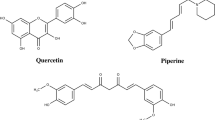Abstract
Trypanothione and trypanothione reductase (TryR)-based redox metabolism found in Leishmania and other trypanosomatids exemplify the unique features of this group of organisms. Its absence in mammalian hosts, together with the sensitivity of trypanosomes against oxidative stress, makes this enzyme a unique target for exploitation for potential antileishmanial chemotherapeutics. Plumbagin, a plant-derived naphthoquinone, is reported to possess antileishmanial properties by inhibiting TryR. We here report the kinetics of the inhibitory mechanism of plumbagin and its derivative, 2-methoxy 1, 4-naphthoquinone. Interestingly, apart from acting as inhibitor, these compounds also act as subversive substrates and subvert the physiological function of enzyme by converting it from an antioxidant to a prooxidant. Both naphthoquinones show a significant effect on redox homeostasis and results in increased reactive oxygen species, resulting in morphological changes and parasite death.





Similar content being viewed by others
References
Babula P, Adam V, Havel L, Kizek R (2009) Noteworthy secondary metabolites naphthoquinones—their occurrence, pharmacological properties and analysis. Curr Pharmaceut Anal 5:47–68
Baiocco P, Franceschini S, Ilari A, Colotti G (2009) Trypanothione reductase from Leishmania infantum: cloning, expression, purification, crystallization and preliminary X-ray data analysis. Protein Pept Lett 16:196–200
Balasubramanyam M, Koteswari AA, Kumar RS, Monickaraj SF, Maheswari JU, Mohan V (2003) Curcumin-induced inhibition of cellular reactive oxygen species generation: novel therapeutic implications. J Biosci 28:715–721
Chemin LS, Lemaire A, Freitas S, Deprez B, Sergheraert C, Charvet ED (2000) Parallel synthesis of a library of 1,4-naphthoquinones and automated screening of potential inhibitors of trypanothione reductase from Trypanosoma cruzi. Bioorg Med Chem Lett 10:631–635
Desjeux P (1992) Human leishmaniases, epidemiology and public health aspects. World Health Stat Q 45:267–275
Gour JK, Srivastava A, Kumar V, Bajpai S, Kumar H, Mishra M, Singh RK (2009) Nanomedicine and leishmaniasis: future prospects. Dig J Nanomat Biostruct 4:495–499
S Habtemariam (2003) In vitro antileishmanial effects of antibacterial diterpenes from two Ethiopian premna species: P. schimperi and P. oligotricha. BMC Pharmacol 471-2210/3/6
Hazra B, Sarkar R, Bhattacharyya S, Ghosh PK, Chel G, Dinda B (2002) Synthesis of plumbagin derivatives and their inhibitory activities against Ehrlich ascites carcinoma in vivo and Leishmania donovani promastigotes in vitro. Phytother Res 16:133–137
Henderson GB, Fairlamb AH, Ulrich P, Cerami A (1987) Substrate specificity of the flavoprotein trypanothione disulfide reductase from Crithidia fasciculata. Biochem 26:3023–3027
Kayser K, Kiderlen AF, Laatsch H, Croft SL (2000) In vitro leishmanicidal activity of monomeric and dimeric naphthoquinones. Acta Trop 77:307–314
Mendez S, Nell M, Alunda JM (1996) Leishmania infantum: infection of macrophages in vitro with promastigotes. Int J Parasitol 26:619–622
Omar F, Khan M (2007) A viable chemotherapeutic target for antitrypanosomal and antileishmanial drug design. Drug Target Insight 1:129–146
Ortega JRL, Lezcano OMR, Croft SL, Rivas L (2001) In vivo monitoring of intracellular ATP levels in Leishmania donovani promastigotes as a rapid method to screen drugs targeting bioenergetic metabolism. Antimicrob Agent Chemother 45:1121–1125
Polonio T, Efferth T (2008) Leishmaniasis: drug resistance and natural products (review). Int J Mol Med 22:277–286
Ray S, Hazra B, Mittra B, Das A, Majumder HK (1998) Diospyrin, a bisnaphthoquinone: a novel inhibitor of type I DNA topoisomerase of Leishmania donovani. Mol Pharma 54:994–999
Shukla AK, Patra S, Dubey VK (2011) Evaluation of selected antitumor agents as subversive substrate and potential inhibitor of trypanothione reductase: an alternative approach for chemotherapy of leishmaniasis. Mol Cell Biochem 352:261–270
Siegel RLK, Comini MA (2008) Redox control in trypanosomatids, parasitic protozoa with trypanothione-based thiol metabolism. Biochim Biophys Acta 1780:1236–1248
Singh BK, Sarkar N, Jagannadham MV, Dubey VK (2008) Modeled structure of trypanothione reductase of Leismania infantum. BMB Rep 41:444–447
Acknowledgements
Infrastructural facilities and research fellowship to NS, AKS, and MD by Indian Institute of Technology Guwahati are acknowledged. Financial support by the Department of Biotechnology Government of India in the form of research grant to VKD (IYBA-2009 scheme and project no.: SAN no. 102/IFD/SAN/PR1827/2008-2009) is also acknowledged. The authors are thankful to Dr. Andrea Ilari and Dr.Gianni Colotti, Università "La Sapienza" Rome, Italy, for providing a clone of TryR and to Dr. A. Sahasrabuddhe, CDRI Lucknow for providing us Leishmania culture for the study.
Author information
Authors and Affiliations
Corresponding author
Rights and permissions
About this article
Cite this article
Sharma, N., Shukla, A.K., Das, M. et al. Evaluation of plumbagin and its derivative as potential modulators of redox thiol metabolism of Leishmania parasite. Parasitol Res 110, 341–348 (2012). https://doi.org/10.1007/s00436-011-2498-x
Received:
Accepted:
Published:
Issue Date:
DOI: https://doi.org/10.1007/s00436-011-2498-x




